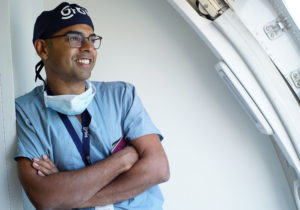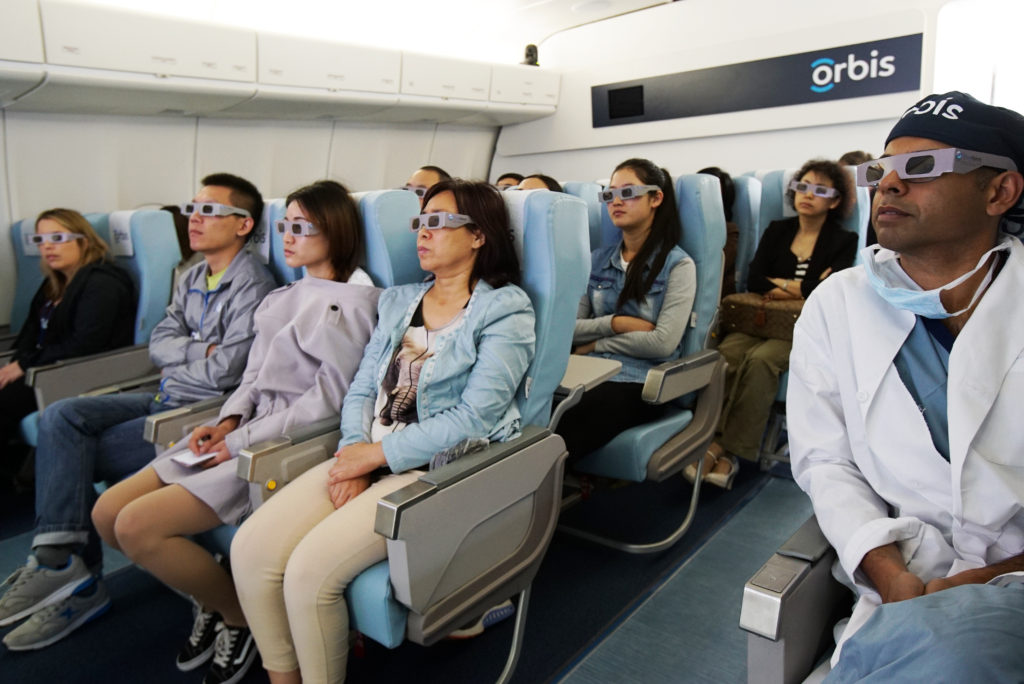
I think if I wasn’t an anaesthetist, I would have liked to have been a pilot. There are a lot of similarities between the two: in terms of responsibility, and that it’s a practical, science based role. My job and my interest in aviation combine perfectly through the charity I volunteer for, Orbis, which fights avoidable blindness across the world, with its in-country programmes and unique Flying Eye Hospital. I first became involved with them because I respect their ethos and their values. I like that they focus on education and building strength, not dependency.
Blindness is an area where people can make a real difference to the needless suffering of millions of people. There are 285 million people in the world who are blind or visually impaired, and 90% of these people live in developing countries where access to eye care is scarce.
Blindness has far reaching implications; children can no longer go to school, adults can no longer contribute to their families or communities. In some cultures, blind people are shunned or discriminated against or even left to die. And, frustratingly, 80% of blindness is either treatable or avoidable. This is where Orbis makes a real difference: through training local medical professionals and treating those who are needlessly blind, we are able to tackle the root causes and offer a truly sustainable means of tackling avoidable blindness.
Since I started volunteering with Orbis, I’ve been on six sight saving expeditions. The majority of these have been with their Flying Eye Hospital—the only ophthalmic teaching facility on board an MD-10 aircraft.
The Flying Eye Hospital is more than just a high tech concept. The environment enables us to share knowledge and skills with local medical professionals in a totally unique way across the medical specialties. For example, the operating room broadcasts surgery to those we’re training in the 46 seat classroom at the front of the plane, in 3D and in real time.

It enables us to go to places where other charities often can’t. In the past it has been to Syria, Cuba, and Taiwan. In its history, the Flying Eye Hospital has visited 78 countries on hundreds of missions. When we were in China recently, we were just 180 miles from the North Korean border. The plane itself is an ambassador and it attracts attention wherever we go. It gives us a spotlight to raise awareness and help prevent avoidable blindness. We often have visits from high ranking governmental officials who are keen to tour the plane and meet the crew and volunteers.
I’m amazed by the people we treat. The children are usually very brave: many have not seen an airplane before, let alone an anaesthetist, yet very few cry or get scared. At the opposite end of the scale, I remember anaesthetising one 82 year old lady in Cambodia, which was unusual. She was remarkably stoical and sailed through her surgery and anaesthesia.

A few months ago, I was lucky enough to be a volunteer during the first programme of the new “third generation” Flying Eye Hospital, which took place in Shenyang, China. Not only had the brand new plane only just launched in June, but it was the 40th Flying Eye Hospital programme in the country.
The anaesthetist that we were training during the programme—despite being qualified—had never had the opportunity to provide local anaesthetics for eye surgery. As the week went on she made rapid progress, eventually doing just that—and very successfully. Not only were the techniques she learnt safe, but, crucially, they are sustainable and used equipment from the local hospital. We always try to bear in mind that one size does not fit all, and we listen to local medical professionals and give them the training they need to work within their own environments.
One of the things Orbis always focuses on is teaching current evidence based best practice, from maintaining hand hygiene to adherence to the World Health Organization (WHO) surgical safety checklist. In a lot of the places we visit, teaching is given a back seat to service delivery. Medical professionals have a huge workload and often don’t get the time, funding, and encouragement for professional development. Orbis helps to change this, ultimately meaning that more people in more countries can access quality eye care.
I’m pleased to report that there were few teething problems with anaesthetising on the new plane. The only omission I could find was a decent cup of coffee—but I am assured that this is work in progress. I’m looking forward to finding out on my next Flying Eye Hospital programme, which is only made possible by the generous donations of Orbis supporters.
Sanjay Saikia is a consultant anaesthetist working at King’s College Hospital, London. He has been a medical volunteer with blindness prevention charity Orbis since 2000. Over the past 16 years he has volunteered in Bangladesh, Nigeria, Peru, China, the Philippines, and Nepal with both the charity’s unique Flying Eye Hospital and within local hospitals.
Donate to Orbis
-
£239 could provide surgical training opportunities on board the Flying Eye Hospital for two local doctors
-
£150 could buy six intraocular lenses for cataract surgery
-
£84 could cover the cost of corrective eye glasses to improve the vision of eight children
-
Donate online: www.orbis.org/bmj/give
-
Donate by phone: +44 (0)20 7608 7260
-
Donate by cheque: Orbis, Freepost RTLK-HLXZ-LKHU, 124-128 City Road, London EC1V 2NJ (no stamp necessary but using one saves sight)
